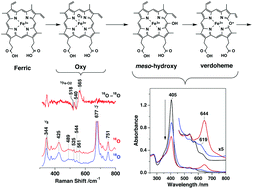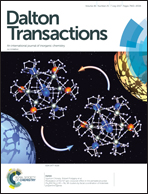Reaction intermediates in the heme degradation reaction by HutZ from Vibrio cholerae†
Abstract
HutZ is a heme-degrading enzyme in Vibrio cholerae. It converts heme to biliverdin via verdoheme, suggesting that it follows the same reaction mechanism as that of mammalian heme oxygenase. However, none of the key intermediates have been identified. In this study, we applied steady-state and time-resolved UV-vis absorption and resonance Raman spectroscopy to study the reaction of the heme–HutZ complex with H2O2 or ascorbic acid. We characterized three intermediates: oxyferrous heme, meso-hydroxyheme, and verdoheme complexes. Our data support the view that HutZ degrades heme in a manner similar to mammalian heme oxygenase, despite their low sequence and structural homology.



 Please wait while we load your content...
Please wait while we load your content...